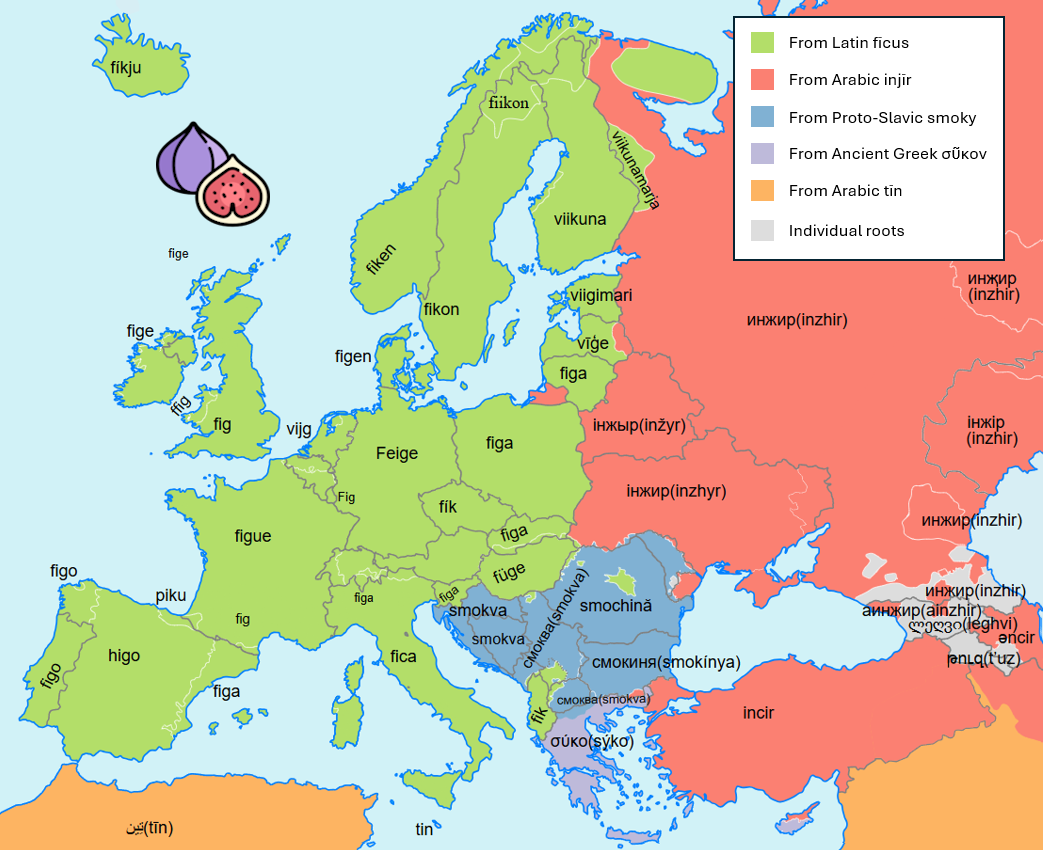Etymology of Fig in European Languages Map


David Chen
Data Visualization Specialist
David Chen is an expert in transforming complex geographic datasets into compelling visual narratives. He combines his background in computer science ...
Geographic Analysis
What This Map Shows
This map visually represents the etymological roots of the word "fig" across various European languages. By examining the linguistic variations and similarities, it uncovers how different cultures have named this beloved fruit, which has been a staple in many diets and traditions. This exploration of language not only highlights the connections between different European cultures but also reflects the historical significance of the fig itself.
Deep Dive into the Etymology of 'Fig'
Figs, scientifically known as *Ficus carica*, have been cultivated since ancient times, and their presence in the diets of Mediterranean civilizations dates back thousands of years. The word “fig” has its origins in Latin, specifically from the term *ficus*. This Latin term has influenced many modern languages, showcasing how the fruit's importance transcended geographic boundaries.
Interestingly, in many Romance languages, the word for fig remains quite similar. For instance, in Spanish, it is *higo*, while in Italian, it is *fico*. Both of these derive from the Latin *ficus*. This linguistic connection illustrates not only the shared heritage among these languages but also the common agricultural practices in their regions. The fig tree has flourished in the Mediterranean climate, making it a vital part of local agriculture.
In contrast, German uses the word *Feige*, which traces its roots back to the Old High German *figa*. This divergence reveals how languages evolve independently, even when they share a common source. In Slavic languages, such as Russian, the word for fig is *инжир* (*inzhir*), which is derived from the Arabic *inab* or *inzhir*, showcasing the influence of Arabic culture and trade routes on Eastern European languages.
Have you noticed how this fruit's name changes from region to region? It’s fascinating to see how trade, migration, and cultural exchange have played a significant role in shaping language. The fig has not only been a crucial food source but also a symbol of prosperity and fertility, which likely influenced its naming across cultures.
Regional Analysis
On the map, we can see distinct linguistic groupings that reflect the geographic distribution of the fig and its related terminology. In Southern Europe, where figs are a staple, countries like Italy, Spain, and Portugal display a close resemblance in their terms. This is likely due to the long-standing agricultural practices and shared culinary traditions surrounding figs.
Moving north into countries like Germany and France, we can observe variations that hint at different agricultural environments and historical influences. For instance, while French uses *figue*, it shares a common root with the terms used in the Southern European languages, yet it has evolved distinctly due to the unique historical and cultural developments in the region.
In Eastern Europe, the influence of trade routes and interactions with Arabic-speaking regions becomes evident. The Slavic term for fig reflects a different set of linguistic influences, showcasing how external factors like trade and conquest can shape language and culture.
Significance and Impact
Understanding the etymology of the word fig across European languages is not merely an academic exercise; it has real-world implications. The fig’s historical significance as a food source is tied to its cultural symbolism. In many Mediterranean cultures, figs are associated with abundance and fertility, often appearing in art and literature. This cultural significance continues today, influencing culinary trends and agricultural practices.
Moreover, the ongoing interest in heritage foods has led to a resurgence in fig cultivation and appreciation across Europe. As more people become aware of the historical and cultural importance of local produce, there’s a growing movement towards sustainable agriculture that honors these traditions. Interestingly, this revival of interest in figs also reflects a broader trend towards valuing local and traditional foods in the context of globalization.
In conclusion, the etymology of the word fig in European languages offers a rich tapestry of cultural history, agricultural significance, and linguistic evolution. As we continue to explore and appreciate the connections between language and culture, the humble fig stands as a delicious reminder of our shared heritage.
Visualization Details
- Published
- October 12, 2025
- Views
- 46
Comments
Loading comments...